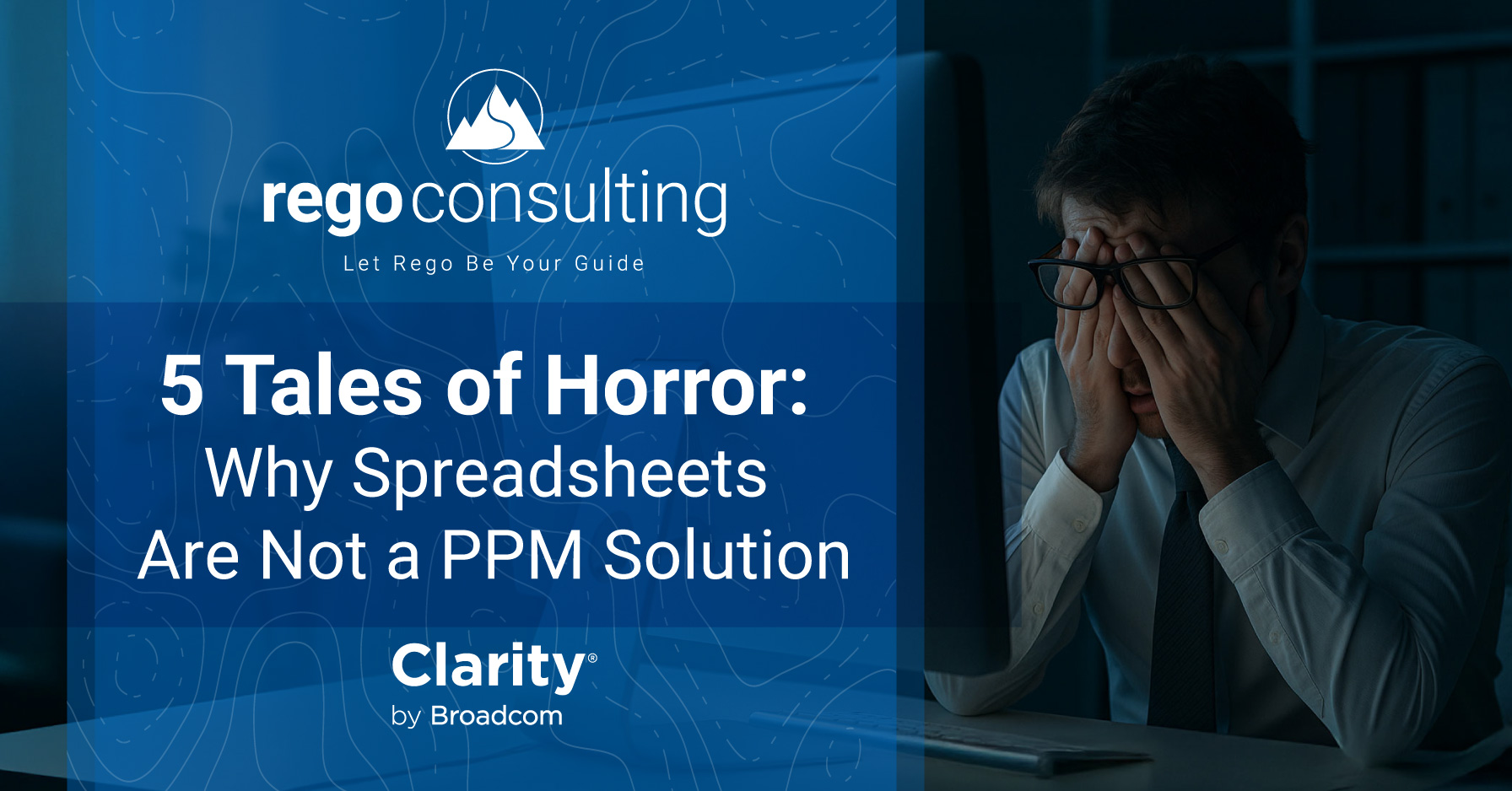Are you looking for out-of-the-box metrics to increase the ROI on your CA PPM (CA Clarity) software? Today we’ll look at some standard metrics you can implement immediately, and this will lead up to the big reveal: our tips on how to utilize adoption metrics to increase your confidence in the standard metrics.
Out-of-the-Box Metrics to Help You Improve Project and Program Performance in CA PPM
As you’d expect, out-of-the-box metrics include Effort, Schedule, and Financial Variances, as well as more than thirty Earned Value Metrics. Scan through this post to see examples and views of standard CA PPM metrics.
Effort Variance
baseline effort versus forecasted effort
Schedule Variance
baseline end dates for tasks, milestones, and projects versus current end dates
Financial Variance
approved project budgets versus current forecasted budgets
Earned Value Metrics
SPI, CPI, ETC, EAC, etc.
To take these metrics to another level, at Rego Consulting we like to add what we call a “confidence factor,” which requires combining standard metrics with adoption or compliance metrics. So you might look at the average effort variance across all your projects and feel absolutely confident they’re correct because your adoption metrics tell you that the project managers have kept all the schedules up-to-date.
Those details on adoption metrics will come in our next post, and we’ll lay the foundation here. What follows are some key points about some of our favorite, standard metrics.
Key Performance Indicators, Out-of-the-Box CA PPM Metrics
You might want to look at Key Performance Indicators by Project Type and combine your schedule variance with a subjective measure, such as a project manager self-reporting being yellow, red, or green.
By matching the subjective measure to your objective schedule variance, you can have confidence in the accuracy of the data, whether it’s goal alignment, overall risk rating, or looking at your issues, allocations, actuals, and resources.
Top 50 Project Watchlist, Out-of-the-Box CA PPM Metrics
The Top 50 Project Watchlist dashboard displays summary data on the fifty projects with your highest resource allocations. This is where you’ll look at alignment, scheduling, and planned versus actual cost.
The gauges and project lists give you easy visibility into key performance indicators, like status, schedule, alignment, risk, issues, and change requests. Pie charts will show you the distribution of issues, risks, and change requests based on your priorities. Checkboxes are also really useful for quickly filtering interests based on critical status, scheduled late, high alignment, and high risk. For example, you can quickly view any highly aligned projects that are also scheduled late.
Project Portfolio Summary, Out-of-the-Box CA PPM Metrics
The Project Portfolio Summary is really nice for looking into the detail of your financial variance percentages. One of its great features allows you to control the Variance parameters, so you can change the background color of positive and negative thresholds.
(In the above screen capture, from page 2 of this particular summary, the Yellow Threshold Variance is set to 10% and higher, whereas the Red Threshold’s parameter is at 15% and higher. Variances less than the Yellow Threshold have no background color.)
Project Earned Value, Out-of-the-Box CA PPM Metrics
Maybe you’re looking into earned value curves across your organization: SPI and CPI. The Project Earned Value report lets you look at planned value versus earned value over time, so you can see if you’re getting better results with a particular project or all your projects at any stage.
The report includes general project information, current performance values, indexes, and cost estimates. It also includes an S-Curve, comparing planned value, actual cost, and earned value amounts by period; and an Indexes Curve, comparing target, CPI, and SPI values by period. Another report option allows you to display the chart in a table format.
Time Compliance, Out-of-the-Box CA PPM Metrics
This simple Time Compliance metric will display timesheet compliance, status, and total percentages relative to each Organized Breakdown Structure (OBS). Timesheets submitted on time are much more likely to be accurate than timesheets submitted two weeks later.
This is where you can view the number of timesheets that are open, submitted, returned, approved, and posted for each OBS unit. Then, to drill down into a detailed sub-report, click the OBS unit and check out status by resource.
(In the above screen capture, the Yellow Threshold Variance is set to 90% and lower, whereas the Red Threshold’s parameter is at 75% and lower. Variances higher than the Yellow Threshold have no background color.)
Overview: Program Dashboard, Out-of-the-Box CA PPM Metrics
This final screenshot of the Program Manager Cost and Schedule Dashboards shows you individual programs and projects, so you can look at your schedule percentages (Am I late?) and individual milestones, like actual cost, EAC, risk, stages, project finish dates, ROI, IRR, BAC, and cost variances.
———–
All of the above metrics come out-of-the-box with CA PPM. It has incredible functionality.
What out-of-the-box metrics are critical to your performance? We’d love to hear what you use, or what you want to start using more, in the comments below.
And if you liked this post, check out this BrightTALK from Daniel Greer, President of Rego Consulting and stay tuned for our next when we’ll start talking in more depth about how to combine traditional metrics with adoption metrics, so you can have higher confidence in your data.
Join our mailing list below.
- Out-of-the-Box Metrics to Help You Improve Project and Program Performance in CA PPM
- Key Performance Indicators, Out-of-the-Box CA PPM Metrics
- Top 50 Project Watchlist, Out-of-the-Box CA PPM Metrics
- Project Portfolio Summary, Out-of-the-Box CA PPM Metrics
- Project Earned Value, Out-of-the-Box CA PPM Metrics
- Time Compliance, Out-of-the-Box CA PPM Metrics
- Overview: Program Dashboard, Out-of-the-Box CA PPM Metrics
- About the Author: Rego Consulting

















